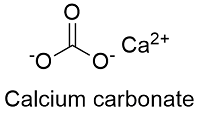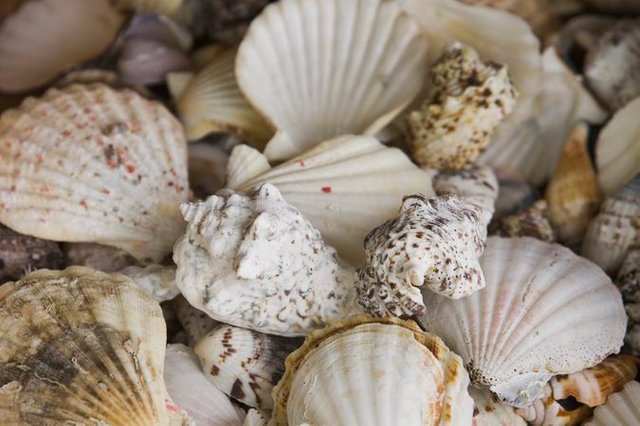Aquaponics Calcium Carbonate
Yesterday, during the radio show, it became obvious from the comments that there were a good many differing ideas about calcium carbonate being used in aquaponics.

Admittedly, I certainly don't know all of the formulations and derivatives of calcium carbonate, so I decided to do some research of my own to help clarify this subject as it relates to aquaponics. As I expressed in one of my other posts to @proffessorbromide, I can only tell you what I have observed from first hand trial and error, and the experience I have so far. To err is human, and I have certainly erred in the past and will certainly err in the future, that is for sure.
I want to try to clear this subject up for myself, as well as for any readers of this blog/post.
I try to use as much organic material as possible in my systems, so this is an important issue.
There are many variations of calcium carbonate, both organic and geologic.
One form is organically derived from things like egg shells, and sea shells. This is the form that I use, and have had good results with.
The other is mineral deposits of various kinds. Now lets be clear on this too, I know that some geologic deposits contain organically derived calcium. But, chances are very good that there will also be a number of other compounds that contribute to the geology surrounding that geologic deposit.
Just to be absolutely clear, I advocate the organically derived calcium carbonate, a.k.a ground up seashells or eggshells, Not the chemically derived or geologically derived. I have a proven track record with this stuff, and a high level of confidence. IT WORKS FOR ME.
If someone has a substance that is proven to work better, then by all means, I am open to it.
And yes as with anything, you can over do it. I generally put 1/2 to 1 cup of organically derived calcium carbonate per 1500 gallons, approximately every 45 days.
This volume of additive is variable due to variable water conditions at the time it is added. I have had conditions where the amount of calcium carbonate additive was double (2 cups) due to the water chemistry at the time. But generally speaking it dissolves very slowly and only needs incremental supplemental amounts added.
Of course this is on a system that is established. If you go pouring calcium carbonate into a brand new system that doesn't need buffering, then yes it can contribute to the overall alkalinity of that start up system. Even so, it is by and large, a slow dissolving substance.

PLEASE NOTE
If your water Ph is low, test the water hardness BEFORE adding anything to balance the pH. I typically keep my water hardness between 3 and 4.
However, If the water hardness is high and pH is low you may need a different solution to bring the pH up.

With all of that said, yes there are other ways of raising pH. lime, lime stone, or even calcium hydroxide, may be added. BUT BE CAREFULL. If you insist on using these geologic, or chemical sources, be aware that typically they are much more concentrated, and tend to react much faster. If you use these, then use small tiny amounts and test the water frequently.
In almost all cases, these types of ph buffering materials are used by seasoned professionals with boat loads of experience, Most with pH...ds. (pun intended).
https://en.wikipedia.org/wiki/Calcium_carbonate
Chemistry
Calcium carbonate shares the typical properties of other carbonates. Notably,
it reacts with acids, releasing carbon dioxide:
CaCO3(s) + 2H+(aq) → Ca2+(aq) + CO2(g) + H2O (l)
it releases carbon dioxide upon heating, called a thermal decomposition reaction, or calcination (to above 840 °C in the case of CaCO3), to form calcium oxide, commonly called quicklime, with reaction enthalpy 178 kJ/mole:
CaCO3 (s) → CaO (s) + CO2 (g)
Calcium carbonate will react with water that is saturated with carbon dioxide to form the soluble calcium bicarbonate.
CaCO3 + CO2 + H2O → Ca(HCO3)2
This reaction is important in the erosion of carbonate rock, forming caverns, and leads to hard water in many regions.
Occurrence
Geological sources
Calcite, aragonite and vaterite are pure calcium carbonate minerals. Industrially important source rocks which are predominantly calcium carbonate include limestone, chalk, marble and travertine.
Calcite is the most stable polymorph of calcium carbonate. It is transparent to opaque. A transparent variety called Iceland spar (shown here) is used for optical purposes.[clarification needed]
Biological sources
Eggshells, snail shells and most seashells are predominantly calcium carbonate and can be used as industrial sources of that chemical.[10] Oyster shells have enjoyed recent recognition as a source of dietary calcium, but are also a practical industrial source.[11][12] Dark green vegetables such as broccoli and kale contain dietarily significant amounts of calcium carbonate, however, they are not practical as an industrial source.[13]
I find that different forms dissolve at different rates in aquaponic systems. When I buy calcium carbonate, I buy organic derived calcium carbonate (typically food grade).
I added lime once only to discover that it turned into slaked lime and killed my fish. At the time I had no idea what caused it because it dissolved quickly into solution and burned the gills of the fish. At that point I had to drain the entire system and start again.
The take away here is, if you want to experiment with inorganic geologic forms of calcium carbonate, or any chemical form of lime to be used as a buffer for your aquaponics system, please, please do it on some water outside of the system with living fish. Once you have determined that you can use it safely, then and only then, add it to your living eco system.
I would encourage everyone to do tests for themselves, and know how things interact with their systems before just dumping something in for a quick fix.
http://drawdoo.com/draw/how-to-draw-fish/

I just want to throw out a huge shout out to @professorbromide for binging up the particulars on this. I had become complacent on this subject and let the particulars slip. This whole thing just drives the point home that the small details matter.
Thanks a million..
Congratulations @robbieolson! You have completed the following achievement on Steemit and have been rewarded with new badge(s) :
Click on the badge to view your Board of Honor.
If you no longer want to receive notifications, reply to this comment with the word
STOP